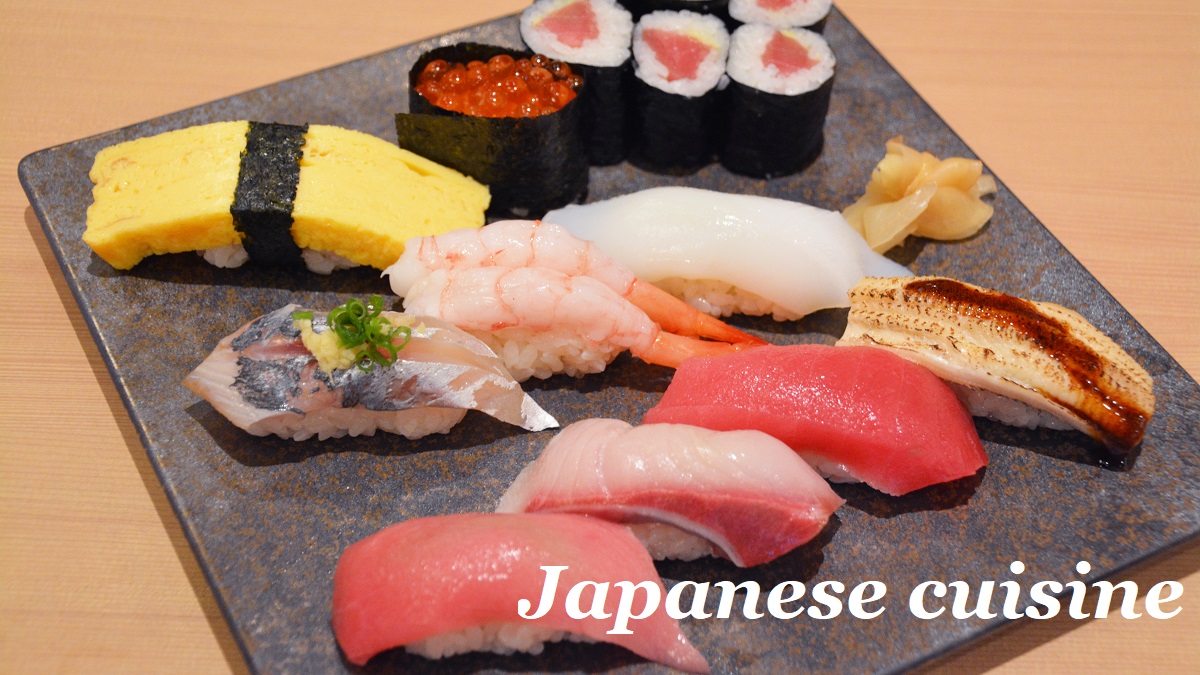Japanese cuisine and foods
Base of Japanese cuisine
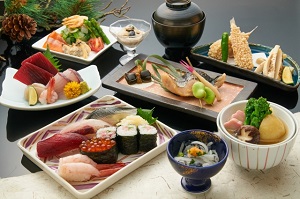
Japanese cuisine is one of Asian cuisine.
But, it is completely different from Chinese, Korean, Thai and the other Asian cuisine.
Roughly speaking, traditional Japanese cuisine has the following features.
- Little oil is used. Fried dish was introduced from overseas.
- Dairy products such as butter, milk are not used.
- Spice is used a little for accent of taste, so it doesn't dominate the taste.
- Main ingredients are fish and vegetables, but meats are secondary.
- Fresh raw food dish is one of the cuisine.
- Cold dish is one of the cuisine.
- The staple is rice.
These features show that Japanese cuisine are healthy and light.
According to the above concept, Japanese dishes are cooked.
I introduce the knowledge about the base of Japanese taste and the methods of the cooking.
First, know the base of Japanese taste.
Second, know the method of Japanese cuisine.
Ingredients for Japanese cuisine
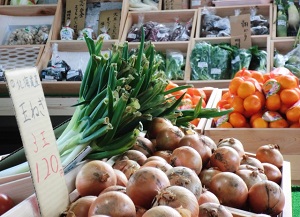
Of course, fish and vegetables are used for Japanese cuisine.
Probably, many of them are the ingredients you know.
But, there are some vegetables unique to Japan.
And, more kinds of fish are used for Japanese cuisine than Western and Chinese cuisine.
Meats are secondary, but they are used for modern Japanese dishes affected by foreign cooking since the 19th century.
First, let's check the main ingredients for Japanese cuisine.
Except for above basic ingredients, there are some processed foods unique to Japan.
They are ready to eat, and are often used as the ingredients of Japanese cuisine.
Probably, when you have a meal in Japan, you will often find them.
Boiled rice as staple food & Japanese soup
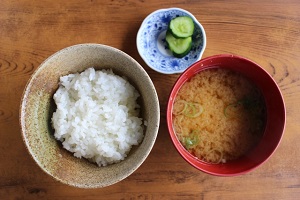
Boiled rice, Miso-soup and Pickles
Rice is the staple of Japan.
In Japanese, raw rice is called "kome", and boiled rice is called "gohan".
And even the meal is often called as "gohan" in Japanese.
Rice is the foundation of Japanese meal.
First, I introduce about rice.
And, when Japanese people use rice, there are not only common boiled rice but also other many variations.
If you know them, you can eat rice more deliciously.
As a substitute for staple food, there are Mochi and bread.
When rice is served, miso-soup is certainly served together.
Miso-soup is called as "Misoshiru" in Japanese.
It is also a daily essential in Japan.
And, there are some variation of Japanese soup including Misoshiru.
Please check the following page about Japanese soup.
Typical Japanese dishes
There are some categories by the way and style of cooking.
First, I introduce the traditional and basic Japanese dishes.
They become a set meal by combining rice and miso-soup.
And, a small amount of pickles are often added as a dish.
The followings are eaten as independent dishes.
There are many restaurants which specialize in each cooking.
In addition, there are the dishes different from traditional Japanese cooking.
But they are widely established as Japanese dishes.
Kaiseki
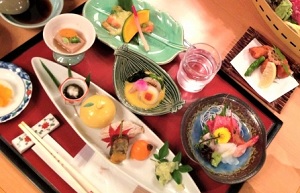
Kaiseki dinner
Kaiseki is the Japanese full course meal.
Commonly, when you stay in the ryokan or hotel, kaiseki dinner is served.
Western-style full dinner is commonly served with consistent set of dishes.
And each dish is sequentially served.
In Kaiseki dinner, tableware of many types, such as earthenware, porcelain, lacquer-ware and bamboo-ware are used.
The color and shape vary.
Generally some dishes are served from the beginning, so you can enjoy various foods since the dinner is started.
Then, a few additional dishes are served.
Contents of Kaiseki dinner
Basically, various dishes are served in the following order.
- Sakizuke / Hassun
"Sakizuke" is the small dishes of local delicacy, and the first dishes of kaiseki. It is like an appetizer.
"Hassun" is the same dish, but a few kind of dishes are on a beautiful small wooden tray, and they are decorated artistically.
Hassun is commonly served in midstream for the meal of tea ceremony, but it is often served from the start at the dinner of ryokan or hotel. - Sashimi
You may be able to eat the local and fresh fish. - Simmered dish
Every cook serve this with using his ingenuity. - Broiled dish
Usually white fish are used. - Deep‐fried dish
Usually tenpura are served. - Steamed dish
"Chawan-mushi" is popular. - Rice, miso soup and pickles
These are served at the last of dinner.
Sometimes, suimono (clear soup) is served instead of miso soup. - Dessert
Dessert is served at the end of dinner.
Usually seasonal fruits or ice cream are served.
Shojin-ryori
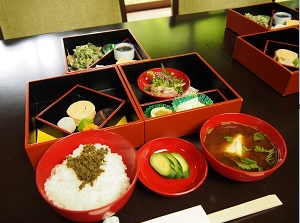
Shojin-ryori
Shojin-ryori is the meal for priest in Buddhist temple.
Fish and meat are not used by Buddhist commandments.
Instead of them, soy beans are mainly used as source of protein.
Therefore, tofu and its product are frequently used.
And, vegitables, mashrooms, konnyaku, seaweeds are exhaustively used.
So, it is completely a vegetarian diet.
When you stay in Shukubo which is a lodging in Buddhist temple, Shojin-ryori is served as the meal.
For visitor, it is served in the style of Kaiseki dinner.
Japanese confections
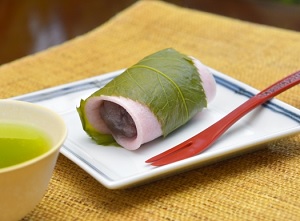
A Japanese confection
While you travel in Japan, you may want to have some sweets.
You can get them at any supermarket, convenience store or confectioner.
You must find chocolate, candy, gum or ice cream.
And you can find traditional Japanese confections there.
Many Western confections include much milk fat of butter and fresh cream, but Japanese confections include low fat.
So they are lower in calories than Western confections.
Of course, there are various types and tastes about Japanese confections.
Please check the following page.
Japanese tea
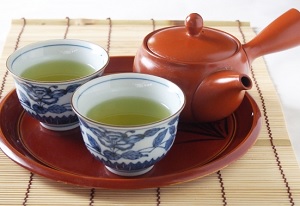
In Japan, "tea" is commonly green tea.
It is called "cha" (茶) or usually politely "ocha".
Japanese tea is slightly bitter, but sugar or milk is never added.
At tea break, Japanese people drink not only coffee or black tea but also green tea, of course.
Additionally, Japanese people drink the tea, after meal or during the desk work.
Plastic bottles of green tea are bought very well, and many people satisfy their thirst with green tea.
When a guest visit us, we make a cup of tea for the guest first.
It is one of the customs of hospitality.
This custom is done at most Japanese restaurants and ryokans.
When you go into a restaurant, a waiter/waitress brings a cup of tea (or water) for you first.
When you are led to your room in a ryokan, the attendant serves a cup of tea for you first.
Of course, they are free service.
(Some restaurants say "Help yourself to drinks.")
But you shouldn't go into a restaurant only to drink the free tea.
Alcoholic beverages in Japan
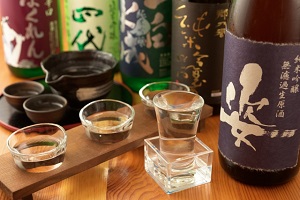
When you travel in Japan, you can drink beer, wine and whisky.
Additionally you can enjoy the traditional Japanese alcoholic beverages.
Major traditional Japanese liquor is "sake" and "shochu".
Sake is the alcoholic beverage made by fermentation, and shochu is distilled alcoholic beverage.
You can drink sake at most restaurants or all Japanese style pubs, and you can enjoy shochu at many pubs.
In passing, if you are under 20 years old, you must not drink alcoholic beverage in Japan.
Of course, if you have drunk, you never drive a car.
Many Japanese restaurants in your country probably serve wrong dishes
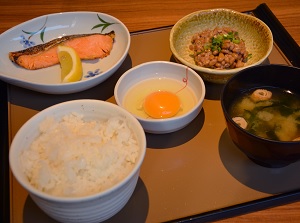
A set lunch of broiled fish
Probably, Japanese dish is one of unique cuisines in the world.
The features at the top of this page are different from any other countries.
The important dashi is made from Katsuobushi and Konbu, and it is very difficult to get them in the countries outside of Japan.
Japanese cuisine values raw dish.
So, sashimi and sushi are the best dishes for Japanese people.
And when the foods are cooked, they are seasoned with only dashi, shoyu, miso, mirin, vinegar, sake, salt or sugar, basically.
So Japanese cuisine has a light flavor, and we can feel the true taste of the ingredients.
Only Japanese people can have such taste sense during the life in Japan.
Probably, it is hard for the foreign cooks to express this Japanese taste.
You may find some Japanese restaurants in your country.
The chefs aren't Japanese in many restarurants.
I hear that many Korean and Chinese chefs similar to Japanese look operate the "Japanese restaurants".
Over 90 percent of overseas Japanese restaurants are operated by non-Japanese chefs.
I think that they serve "Japanized dishes by foreign cooks".
If you think it taste good, I have no cause to complain.
But, I'm unhappy that you recognize such dish as the real Japanese cuisine.
Many Japanese overseas travelers reported that such restaurants disappointed them because the dishes were different from normal Japanese dishes.
(I hear that some restaurants hate when Japanese guests come.)
Please, visit Japan, and enjoy the real Japanese cuisine.

